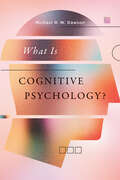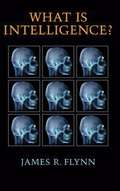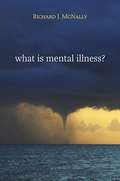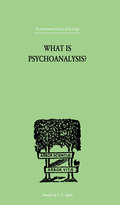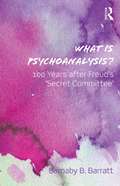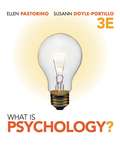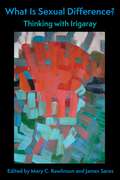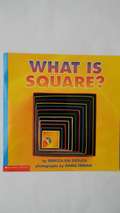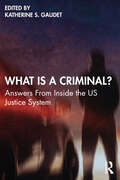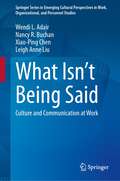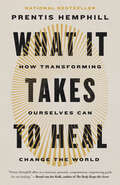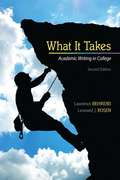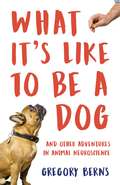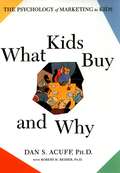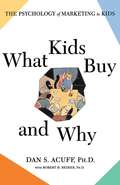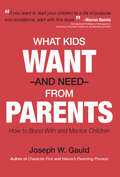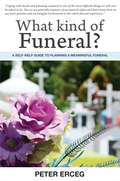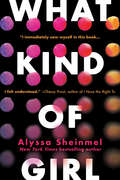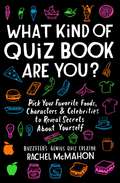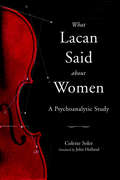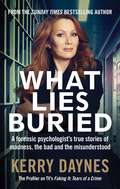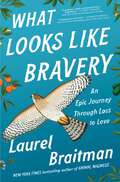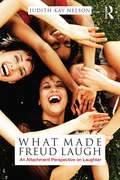- Table View
- List View
What Is Cognitive Psychology?
by Michael R.W. DawsonWhat Is Cognitive Psychology? identifies the theoretical foundations of cognitive psychology—foundations which have received very little attention in modern textbooks. Beginning with the basics of information processing, Michael R. W. Dawson explores what experimental psychologists infer about these processes and considers what scientific explanations are required when we assume cognition is rule-governed symbol manipulation. From these foundations, psychologists can identify the architecture of cognition and better understand its role in debates about its true nature. This volume offers a deeper understanding of cognitive psychology and presents ideas for integrating traditional cognitive psychology with more modern fields like cognitive neuroscience.
What Is Intelligence? Beyond the Flynn Effect
by James R. FlynnProfessor James Flynn is one of the most creative and influential psychologists in the field of intelligence. The 'Flynn Effect' refers to the massive increase in IQ test scores over the course of the twentieth century and the term was coined to recognize Professor Flynn's central role in measuring and analyzing these gains. For over twenty years, psychologists have struggled to understand the implications of IQ gains. Do they mean that each generation is more intelligent than the last? Do they suggest how each of us can enhance our own intelligence? Professor Flynn is finally ready to give his own views. He asks what intelligence really is and gives a surprising and illuminating answer. This book bridges the gulf that separates our minds from those of our ancestors a century ago. It is a fascinating and unique book that makes an important contribution to our understanding of human intelligence.
What Is It Like to Be Me?: A Book About a Boy with Asperger's Syndrome
by Tony Attwood Ursa Rozic Alenka Klemenc Branka D Jurisic Katarina Kompan ErzarJoin Greg, a young boy with Asperger's syndrome (AS), as he tells us all about the world as he sees and experiences it. We learn about all the things he loves, including his routine and numbers, as well as his special interest in batteries (he even has a rectangular one!). Greg also tells us about the things that he finds challenging, from a change in his beloved routine to reading facial expressions, and how these things can sometimes leave him upset and overwhelmed. By explaining the way he feels and how best to calm him down when it all gets too much, Greg helps us to understand AS and how it affects the way he views the people and objects around him. With comprehensive sections for parents and professionals on AS and the impact it can have on the family unit and life in the wider community, this charmingly illustrated book helps to increase awareness and understanding of Asperger's syndrome. It will be of interest to families of children with autism spectrum disorders, as well as teachers and other professionals working with children on the autism spectrum.
What Is Mental Illness
by Richard J. McNallyMcNally argues, no science can draw a bright line between disorder and distress. In a pragmatic and humane conclusion, he offers questions for patients and professionals alike to help understand, and cope with, the sorrows and psychopathologies of everyday life.
What Is Mental Illness?
by Richard J. McNallyAccording to a major health survey, nearly half of all Americans have been mentally ill at some point in their lives—more than a quarter in the last year. Can this be true? What exactly does it mean, anyway? What’s a disorder, and what’s just a struggle with real life? This lucid and incisive book cuts through both professional jargon and polemical hot air, to describe the intense political and intellectual struggles over what counts as a “real” disorder, and what goes into the “DSM,” the psychiatric bible. Is schizophrenia a disorder? Absolutely. Is homosexuality? It was—till gay rights activists drove it out of the DSM a generation ago. What about new and controversial diagnoses? Is “social anxiety disorder” a way of saying that it’s sick to be shy, or “female sexual arousal disorder” that it’s sick to be tired? An advisor to the DSM, but also a fierce critic of exaggerated overuse, McNally defends the careful approach of describing disorders by patterns of symptoms that can be seen, and illustrates how often the system medicalizes everyday emotional life. Neuroscience, genetics, and evolutionary psychology may illuminate the biological bases of mental illness, but at this point, McNally argues, no science can draw a bright line between disorder and distress. In a pragmatic and humane conclusion, he offers questions for patients and professionals alike to help understand, and cope with, the sorrows and psychopathologies of everyday life.
What Is Psychoanalysis?
by Coriat, Isador HFirst Published in 1999. Routledge is an imprint of Taylor & Francis, an informa company.
What Is Psychoanalysis?: 100 Years after Freud's 'Secret Committee'
by Barnaby B BarrattIn a radically powerful interpretation of the human condition, this book redefines the discipline of psychoanalysis by examining its fundamental assumptions about the unconscious mind, the nature of personal history, our sexualities, and the significance of the "Oedipus Complex". With striking originality, Barratt explains the psychoanalytic way of exploring our inner realities, and criticizes many of the schools of "psychoanalytic psychotherapy" that emerged and prospered during the 20th century. In 1912, Sigmund Freud formed a "Secret Committee", charged with the task of protecting and advancing his discoveries. In this book, Barratt argues both that this was a major mistake, making the discipline more like a religious organization than a science, and that this continues to infuse psychoanalytic institutes today. What is Psychoanalysis? takes each of the four "fundamental concepts" that Freud himself said were the cornerstones of his science of healing, and offers a fresh and detailed re-examination of their contemporary importance. Barratt's analysis demonstrates how the profound work, as well as the playfulness, of psychoanalysis, provides us with a critique of the ideologies that support oppression and exploitation on the social level. It will be of interest to advanced students of clinical psychology or philosophy, as well as psychoanalysts and psychotherapists.
What Is Psychology?
by Susann Doyle-Portillo Ellen PastorinoEllen Pastorino and Susann Doyle-Portillo are dedicated, award-winning psychology professors with an infectious enthusiasm for teaching psychology. Praised in previous editions for fostering students' curiosity, WHAT IS PSYCHOLOGY? Third Edition, extends the authors' successful and engaging approach to teaching the introductory psychology course. The authors have found that when students are curious they are motivated to explore and truly learn how psychological concepts are connected. This book unlocks readers' curiosity by capturing their interest and then helping them see connections between personal stories, applications to their own lives, and psychological concepts that they will use and retain in and out of the classroom.
What Is Sexual Difference?: Thinking with Irigaray
by Mary C. Rawlinson and James SaresLuce Irigaray has written that “sexual difference is one of the major philosophical issues, if not the issue, of our age.” Spanning metaphysics, phenomenology, and psychoanalysis, her work examines how sexual difference structures being and subjectivity, organizes our experience of the world, and affects the images and discourses involved in knowledge production and practical action. No other philosopher has paid such careful attention to the consequences of the elision of sexual difference in philosophical thought. However, at a time when notions of sexual and gender difference are hotly contested, Irigaray’s thought has often been dismissed as essentialist or reductively binary.This book brings together leading scholars to consider the philosophical implications of Irigaray’s writing on sexual difference, particularly for issues of gender and race. Their essays directly confront the charge of essentialism, exploring how Irigaray’s thought opens new possibilities for understanding the complexity of gender identities, including nonbinary and trans experiences as well as alternative configurations of masculinity and femininity. Though Irigaray is sometimes accused of a failure to appreciate racial difference, contributors show the productive role of her work in thinking race. This book also illuminates how Irigaray’s work provides creative practices that help realign human experience and our relations with nature and each other.
What Is a Criminal?: Answers From Inside the US Justice System
by Katherine S. GaudetBringing together a collection of essays by writers with diverse knowledge of the US criminal justice system, from those with personal experience in prison and on patrol to scholarly researchers, What Is a Criminal? explores the category of "criminal" through the human stories of those who bear and administer that label. This book performs a rare feat in bringing together the perspectives of justice-impacted people, those who work in law enforcement and social services, and scholarly researchers. Each chapter is a compelling narrative sharing the experience and perspective of a unique person with knowledge of the justice system. The first section, "Incarceration, Reentry, and Rebuilding," gives a glimpse into the "black box" of prison, with firsthand accounts of daily life on the inside and the struggle to begin a new life after prison. Section 2, "Journeys in Law Enforcement," presents perspectives from police officers, school resource officers, and corrections officers who are working to better their communities. The third section, "Ripple Effects," addresses some of the broader impacts of the justice system, showing what it is like to be the child of an incarcerated parent, to be profiled, to be an undocumented immigrant, and to make art about the justice system. The final section, "Scholarly Perspectives," is comprised of accessible articles by academics who study law and crime. Each chapter stands alone as an individual story, but taken together they provide a uniquely nuanced view of the US justice system. This book will be of interest to anyone who wants to know more about criminality, the US justice system, and the people involved in it. It is designed for a general audience, with accessible, compelling stories that will appeal to a variety of readers. It is an effective text for college and high school courses about crime and criminality, and provides excellent fodder for discussion in law enforcement and social services training programs or professional development workshops.
What Isn’t Being Said: Culture and Communication at Work (Springer Series in Emerging Cultural Perspectives in Work, Organizational, and Personnel Studies)
by Xiao-Ping Chen Leigh Anne Liu Wendi L. Adair Nancy R. BuchanThis book examines how exactly effective intercultural communication at work takes place. In order to do so, the authors take a deep dive into understanding the communication process and variation in communication patterns across cultures and individuals. They introduce a model that focuses on four sources of nonverbal communication, discuss existing research on intercultural communication in the workplace, and offer propositions for future research on the indirect, implicit, and nonverbal cues that can stymie cross-cultural communication effectiveness at work.
What It Takes to Heal: How Transforming Ourselves Can Change the World
by Prentis HemphillNATIONAL BESTSELLER • From one of the most prominent voices in the trauma conversation comes a groundbreaking new way to heal on a personal and a collective level, showing us that we don&’t have to carry our emotional burdens alone.&“I love this book.&”—Bessel van der Kolk, author of The Body Keeps the Score&“In a time when so many of us are being trained in cynicism, this book stands in necessary defiance.&”—Cole Arthur Riley, author of Black Liturgies and This Here FleshWhat It Takes to Heal asserts that the principles of embodiment—the recognition of our body&’s sensations and habits, and the beliefs that inform them—are critical to lasting healing and change. Hemphill, an expert embodiment practitioner, therapist, and activist who has partnered with Brené Brown, Tarana Burke, and Esther Perel, among others, demonstrates a future in which healing is done in community. Hemphill weaves together stories from their own experience as a trauma survivor with clinical accounts and lessons learned from their time as a social movement architect. They ask, &“What would it do to movements, to our society and culture, to have the principles of healing at the very center? And what does it do to have healing at the center of every structure and everything we create?&”In this life-affirming framework for the way forward, Hemphill shows us how to heal our bodies, minds, and souls—to develop the interpersonal skills necessary to break down the doors of disconnection and take the necessary risks to reshape our world toward justice.
What It Takes: Academic Writing in College
by Laurence Behrens Leonard J. RosenWhat It Takes: Academic Writing in College prepares the reader for the most common college writing assignments: the summary, the critique, the synthesis, and the analysis.
What It's Like to Be a Dog: And Other Adventures in Animal Neuroscience
by Gregory BernsWhat does your dog really think about you? To find out, Gregory Berns became the first neuroscientist to persuade dogs to lie in an MRI machine wide awake. Now we know more about our best friends than ever before – how varying capacities for self-control and different value systems set them apart as individuals, and how deeply they understand the words we speak to them. Berns&’ discoveries have profound implications for how we communicate with and treat these beloved animals. But he didn&’t stop there. Berns also delves into the inner lives of sea lions, bats, dolphins, and even the extinct Tasmanian tiger. His revolutionary explorations are essential reading for animal lovers of all stripes.
What Kids Buy and Why
by Daniel AcuffIf you're in the business of marketing or developing products and programs for kids, What Kids Buy and Why belongs in your office. How can you create outstanding products and programs that will win in the marketplace and in the hearts of kids and parents? Dan S. Acuff and Robert H. Reiher have invented a development and marketing process called Youth Market Systems that puts the needs, abilities, and interests of kids first. This system makes sure you won't miss the mark whether you're trying to reach young children or teens, boys or girls, or whether you're selling toys, sports equipment, snacks, school supplies, or software. Based on the latest child development research, What Kids Buy and Why is chock-full of provocative information about the cognitive, emotional, and social needs of each age group. This book tells you among other things-why 3-through-7-year-olds love things that transform, why 8-through-12-year-olds love to collect stuff, how the play patterns of boys and girls differ, and why kids of all ages love slapstick. What Kids Buy and Why is the result of Acuff and Reiher's almost twenty years of consulting with high-profile clients including Johnson & Johnson, Nike, Microsoft, Nestlé, Tyco, Disney, Pepsi, Warner Brothers, LucasFilm, Amblin/Spielberg, Mattel, Hasbro, Kraft, Coca-Cola, Quaker Oats, General Mills, Broderbund, Bandai, Sega, ABC, CBS, I-HOP, Domino's, Hardee's, and Kellogg's. Special features include: an innovative matrix for speedy, accurate product analysis and program development a clear, step-by-step process for making decisions that increase your product's appeal to kids tools and techniques for creating characters that kids love Here is the complete one-stop tool for understanding what children of all ages want to buy.
What Kids Buy and Why
by Daniel Acuff Robert H ReiherBased on the latest child development research, What Kids Buy and Why is chock-full of provocative information about the cognitive, emotional, and social needs of each age group. This book tells you - among other things - why 3-through-7-year-olds love things that transform, why 8-through-12-year-olds love to collect stuff, how the play patterns of boys and girls differ and why kids of all ages love slapstick. Special features include an innovative matrix for speedy, accurate product analysis and program development; a clear, step-by-step process for making decisions that increase your product's appeal to kids; and tools and techniques for creating characters that kids love.
What Kids Want and Need From Parents
by Joseph Warren GauldWhat Kids Want-And Need-From Parents is truly a seminal book in parenting.It begins with one man's 50-year journey to discover a better way to prepare American kids for life and culminates with the amazing discovery: the biggest factor in children's success in life turns out to be dependent on how their parents deal with their own childhood!Teacher Joe Gauld sets out to change American education in the 60s, founding the Hyde School in Bath, Maine, committed to the idea every student is gifted with a unique potential. But by tracking Hyde graduates in life, he finds parenting a much larger influence on their later lives than schooling. So in 1974, he begins a program to regularly address parental growth and family issues.Hyde's extraordinary ability to bond family and school receives national media attention, and Hyde grows into a network of seven private and public schools, plus a national Hyde Biggest Job® parent program.Joe increasingly centers his work on families, finding parenting heavily influenced by how parents were raised. So parents' learning how to effectively deal with both the negative as well as the positive aspects of their upbringing becomes critical to effective parenting. Joe carefully leads the reader through this dynamic and ground-breaking parenting process.
What Kind of Funeral?: A Self-help Guide To Planning A Meaningful Funeral (What Kind Of Funeral? Ser.)
by Peter ErcegThe death of a loved one is a difficult and emotional time for everyone. For most of us, coping with death and planning a funeral is one of the most difficult things we will ever be asked to do. Yet, we are generally unaware of our funeral rights and don’t know how we can have genuine and meaningful involvement in the funeral.In this book, Peter Erceg informs and empowers you so that you can have more involvement in the whole experience. He provides independent and practical advice on how you can make informed decisions about all funeral-related matters. You’ll discover:How to plan a personal and meaningful funeral.How to deal with death, bereavement and the funeral process.How to create a unique commemoration of the deceased.How to arrange a funeral without using a funeral director.How to administer the deceased’s affairs when the funeral is over.How to manage a digital life after death.How to cope with the loss of a pet.How baby boomers are changing trends in the funeral industry.“Coping with death and planning a funeral is one of the most difficult things we will ever be asked to do. Yet, we are generally unaware of our funeral rights and don’t know how we can have genuine and meaningful involvement in the whole funeral experience.”
What Kind of Girl
by Alyssa SheinmelWhat kind of girl stays after her boyfriend hits her? <P><P>The girls at North Bay Academy are taking sides. It all started when Mike Parker's girlfriend showed up with a bruise on her face. Or, more specifically, when she walked into the principal's office and said Mike hit her. But her classmates have questions. Why did she go to the principal and not the police? Why did she stay so long if Mike was hurting her? Obviously, if it's true, Mike should be expelled. But is it true? <P><P>Some girls want to rally for his expulsion—and some want to rally around Mike. The only thing that the entire student body can agree on? Someone is lying. And the truth has to come out.
What Kind of Quiz Book Are You?: Pick Your Favorite Foods, Characters, and Celebrities to Reveal Secrets About Yourself
by Rachel McMahonFrom BuzzFeed’s quiz-making genius—a witty and irresistible collection of whip-smart and pop culture savvy quizzes that reveals secrets and quirks you never knew about yourself. Who hasn’t clicked on an online quiz that suggests your choice of Pop Tart flavor (or favorite Jonas brother) will reveal your relationship status or hidden personality traits? (Hint: hundreds of millions of people have done this, and counting!) Perfect for all ages and backgrounds, this fun, light-hearted, and thought-provoking collection features both brand new and popular quizzes directly from BuzzFeed’s viral sensation Rachel McMahon. Featuring additional irreverent commentary and breakdowns of quiz outcomes not previously published on such topics as who is your celebrity boyfriend based on what frozen yogurt you like to finding out whether you are more Phineas or Ferb based on your favorite sandwich toppings, What Kind of Quiz Book Are You? is an entertaining and laugh-out-loud collection like no other, destined to become as addictive as coloring books.
What Lacan Said About Women: A Psychoanalytic Study (Contemporary Theory Ser.)
by Colette SolerThe definitive work on Lacan's theory of the feminine.With exquisite prose and penetrating insights, Colette Soler shares her theoretical and clinical expertise in this vibrant new text. She spins out seductive explications of Lacan's thought on the controversial question of sexual difference. With the subtlety that these topics deserve, she takes up Lacan's conception of woman and her relation to masochism, femininity and hysteria, love and death, and the impossible sexual relation. Following more than the usual suspects, What Lacan Said About Women also explores the mother's place in the unconscious, how Lacan understands depression, and why depressives feel unloved.Soler's analysis examines the cultural implications of the texts that Lacan produced from the 1950s to the 1970s, such as the effects of science on contemporary conceptions of the feminine. She gracefully bridges the gap still left open between psychoanalysis and cultural studies. Winner of the Prix Psyche for the best work published in the fields of psychology and psychoanalysis in 2003, this book will appeal to cultural critics, especially those in gender and women's studies, as well as to anyone involved in contemporary theory or clinical practice. This study will transform novices within the field of Lacanian theory into informed thinkers and it will substantially supplement and refine the knowledge of Lacanian veterans.
What Lies Buried: A forensic psychologist's true stories of madness, the bad and the misunderstood
by Kerry DaynesTHE MUCH-ANTICIPATED NEW BOOK FROM THE AUTHOR OF THE SUNDAY TIMES BESTSELLER THE DARK SIDE OF THE MIND.'Pacy and gripping. Daynes uses her trademark mix of humour and humanity to shine a light on those we rarely get to hear from. A brilliant, important and sensitive book.' SARAH LANGFORD, bestselling author of In Your DefenceKerry Daynes, leading forensic psychologist, opens up the case files of some of her most perplexing clients to uncover what lies buried behind some of the most extreme and disturbing behaviour.Whether she is dealing with a young murderer who says he has heard voices telling him to kill, a teacher who daubs children in red paint and threatens to abduct them, or an aspiring serial killer who faints at the sight of blood, Kerry's quest is to delve beyond the classic question asked of her profession: 'Are they mad or are they bad?'In her new book, Kerry provides an unflinching, enlightening and provocative insight into the minds of her clients, shedding light on the root causes of their behaviour and challenging our notions about who, and what, is dangerous. If you enjoyed The Dark Side of the Mind, Unnatural Causes and The Prison Doctor, you will be captivated by What Lies Buried.
What Looks Like Bravery: An Epic Journey Through Loss to Love
by Laurel BraitmanA true story about the ways loss can transform us into the people we want to become.Laurel Braitman spent her childhood learning how to outfish grown men, keep bees, and fix carburetors from her larger-than-life dad. Diagnosed with terminal cancer, he went to spectacular lengths to teach her the skills she&’d need to survive without him. But by her mid-thirties she is a ship about to splinter on the rocks, exhausted by running from her own bad feelings. We follow as Laurel changes course, navigating multiple wildernesses—from northern New Mexico and western Alaska to her own Tinder app. She learns the hard way that no achievement, no matter how shiny, can protect her from pain, and works to transform guilt and regret into gold: learning from a badass birder in the Bering Sea, a few dozen grieving kids in a support group, a pile of smoking ashes, and countless online dates. Along the way, she faces a wildfire that threatens everyone and everything she cares about, a grueling test of her own survival skills, and the fact that we often have to say our hardest goodbyes before we&’re ready. In the end Laurel realizes that being open to love after loss is not only possible, it can set us free.What Looks Like Bravery is a hero&’s journey for our times. Laurel teaches us that hope is a form of courage, one that can work as an all- purpose key to the locked doors of your dreams.
What Made Freud Laugh: An Attachment Perspective on Laughter
by Judith Kay NelsonIn her characteristically engaging style, Nelson explores a topic that has fascinated and frustrated scholars for centuries. Initially drawn to the meaning of laughter through her decades of work studying crying from an attachment perspective, Nelson argues that laughter is based in the attachment system, which explains much about its confusing and apparently contradictory qualities. Laughter may represent connection or detachment. It can invite closeness, or be a barrier to it. Some laughter helps us cope with stress, other laughter may serve as a defense and represent resistance to growth and change. Nelson resolves these paradoxes and complexities by linking attachment-based laughter with the exploratory/play system in infancy, and the social/affiliative system, the conflict/appeasement, sexual/mating, and fear/wariness systems of later life. An attachment perspective also helps to explain the source of different patterns and uses of laughter, suggests how and why they may vary according to attachment style, and explain the multiple meanings of laughter in the context of the therapeutic relationship. As she discovers, attachment has much to teach us about laughter, and laughter has much to teach us about attachment. This lively book sheds light on the ways in which we connect, grow, and transform and how, through shared humor, play, and delight, we have fun doing so.
